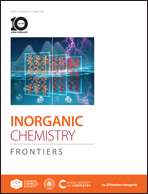Target-specific isolation of light-switchable metal–organic cages within metal–organic frameworks for tunable CO2 adsorption†
Abstract
Light-switchable metal–organic cages (LMOCs), which are intriguing supramolecules with tunable functionality and diverse structural features, have been recognized as promising candidates for trapping gas molecules. However, the active sites and switchability are often compromised because of the severe aggregation of bulk LMOCs, which constrains their practicability in light-switchable applications. Herein, we report a facile strategy, by isolating LMOCs into the targeted pores of metal–organic frameworks (MOFs) with light-assisted precise size control, to improve the dispersity of LMOC molecules, along with the intensification of switchability and the accessibility of active sites and cage spaces. In addition, reversible trans/cis isomerization of light-switchable motifs in LMOCs can be achieved upon UV/vis-light irradiation, maximizing control over the light-switchable CO2 adsorption behavior. Importantly, the isolated LMOC exhibits 27.2% change in adsorption capacity for CO2 upon trans/cis isomerization, which is significantly superior to that of the bulk LMOC, with 5.6% change. The present work offers a facile route for the development of new composite materials with isolated light-switchable motifs for tunable CO2 adsorption.

- This article is part of the themed collection: 2023 Inorganic Chemistry Frontiers HOT articles


 Please wait while we load your content...
Please wait while we load your content...